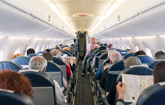Delta Announces Plan to Return More Than $1 Billion to Shareholders Over Next Three Years
Board of Directors initiates $0.06 per share quarterly dividend, authorizes $500 million share repurchase
Balanced capital deployment creates up to $5 billion of value for shareholders through further debt reduction, return of cash to shareholders, and management of pension liability
ATLANTA, May 8, 2013 /PRNewswire/ -- In a broad financial plan released today, Delta Air Lines (NYSE:DAL) announced a balanced capital deployment program aimed at creating up to $5 billion of value for shareholders, including returning more than $1 billion to shareholders over the next three years.
(Logo: http://photos.prnewswire.com/prnh/20090202/DELTALOGO )
As part of this program, Delta's Board of Directors has initiated a quarterly dividend and declared a $0.06 per share dividend for shareholders of record as of Aug. 9, 2013. This dividend will be paid on Sept. 10, 2013. In addition, the Board has authorized a $500 million share repurchase program, to be completed no later than June 30, 2016. Together, these two programs are designed to return more than $1 billion of capital to shareholders over the next three years.
"Delta's financial performance and balance sheet have strengthened considerably over the past five years and the Board believes the company is now in a position to begin returning cash to our shareholders," said Daniel Carp, chairman of Delta's Board of Directors. "The Board's shareholder return program makes a long-term commitment to our shareholders with the implementation of an ongoing quarterly dividend, while also providing flexibility to return additional cash to shareholders through the share repurchase program."
Comprehensive Financial Plan
Since 2009, Delta has made significant investments in its people, product and service, while improving its earnings and generating $4 billion of free cash flow. That free cash flow has been dedicated to strengthening the company's balance sheet. As a result, Delta's adjusted net debt has fallen from $17 billion at the end of 2009 to just under $12 billion at the end of 2012. The company expects to achieve its $10 billion adjusted net debt target by the end of 2013.
"Delta's strategy has resulted in a solid financial foundation for our company, tremendous improvements in our fleet, facilities, products and technology, as well as top-notch operational reliability and service to our customers," said Richard Anderson, Delta's chief executive officer. "The capital deployment plan unveiled today furthers our commitment to becoming the airline of choice for our employees, customers and shareholders."
In an investor presentation this morning, Delta outlined a comprehensive, five-year financial plan. The plan focuses on free cash flow generation through a combination of expected earnings improvements and a disciplined approach to capital investment. Over the next five years, the company plans to reinvest $2.0 - $2.5 billion annually, or approximately 50 percent of its operating cash flow, into improving the company's fleet, facilities, products and technology. The resulting free cash flow will be used to return cash to shareholders, further reduce the company's debt, and opportunistically address longer-term pension funding needs, driving up to $5 billion of value to Delta's shareholders.
As part of this plan, Delta expects to achieve and maintain an adjusted net debt level of $7 billion, a $5 billion reduction over 2012. By meeting the $7 billion target, Delta will have reduced its adjusted net debt by $10 billion since 2009, significantly decreasing the company's balance sheet risk and generating more than 50 percent savings in interest expense.
The company also plans to make up to $1 billion of incremental contributions to the company's defined benefit pension plans over the next five years. These contributions would be in addition to the $650 - $700 million annual required minimum contribution.
More information on Delta's comprehensive financial plan can be found as an exhibit to a Form 8-K the company filed with the Securities and Exchange Commission this morning.
Repurchases under Delta's program may be made through a variety of methods, which may include open market purchases, privately negotiated transactions, block trades, or accelerated share repurchase transactions in compliance with applicable regulatory guidelines, including Securities and Exchange Commission Rule 10b-18. Purchases will be made subject to market and economic conditions, applicable legal requirements, and other relevant factors. Delta had approximately 855 million shares of common stock outstanding as of March 31, 2013.
About Delta
Delta Air Lines serves more than 160 million customers each year. Delta was named by Fortune magazine as the most admired airline worldwide in its 2013 World's Most Admired Companies airline industry list, topping the list for the second time in three years. With an industry-leading global network, Delta and the Delta Connection carriers offer service to 317 destinations in 58 countries on six continents. Headquartered in Atlanta, Delta employs nearly 80,000 employees worldwide and operates a mainline fleet of more than 700 aircraft. The airline is a founding member of the SkyTeam global alliance and participates in the industry's leading trans-Atlantic joint venture with Air France-KLM and Alitalia. Including its worldwide alliance partners, Delta offers customers more than 15,000 daily flights, with hubs in Amsterdam, Atlanta, Cincinnati, Detroit, Memphis, Minneapolis-St. Paul, New York-LaGuardia, New York-JFK, Paris-Charles de Gaulle, Salt Lake City and Tokyo-Narita. Delta is investing more than $3 billion in airport facilities and global products, services and technology to enhance the customer experience in the air and on the ground. Additional information is available on delta.com, Twitter @Delta, Google.com/+Delta and Facebook.com/delta.
Forward-looking Statements
Statements in this investor update that are not historical facts, including statements regarding our estimates, expectations, beliefs, intentions, projections or strategies for the future, may be "forward-looking statements" as defined in the Private Securities Litigation Reform Act of 1995. All forward-looking statements involve a number of risks and uncertainties that could cause actual results to differ materially from the estimates, expectations, beliefs, intentions, projections and strategies reflected in or suggested by the forward-looking statements. These risks and uncertainties include, but are not limited to, the cost of aircraft fuel; the availability of aircraft fuel; the impact of posting collateral in connection with our fuel hedge contracts; the impact of significant funding obligations with respect to defined benefit pension plans; the impact that our indebtedness may have on our financial and operating activities and our ability to incur additional debt; the restrictions that financial covenants in our financing agreements will have on our financial and business operations; labor issues; interruptions or disruptions in service at one of our hub airports; our dependence on technology in our operations; disruptions or security breaches of our information technology infrastructure; the ability of our credit card processors to take significant holdbacks in certain circumstances; the possible effects of accidents involving our aircraft; the effects of weather, natural disasters and seasonality on our business; the effects of an extended disruption in services provided by third party regional carriers; failure or inability of insurance to cover a significant liability at the Trainer refinery; the impact of environmental regulation on the Trainer refinery; our ability to retain management and key employees; our ability to use net operating losses to offset future taxable income; competitive conditions in the airline industry; the effects of extensive government regulation on our business; the effects of terrorist attacks; the effects of the rapid spread of contagious illnesses; and the costs associated with insurance.
Additional information concerning risks and uncertainties that could cause differences between actual results and forward-looking statements is contained in our Securities and Exchange Commission filings, including our Annual Report on Form 10-K for the fiscal year ended Dec. 31, 2012. Caution should be taken not to place undue reliance on our forward-looking statements, which represent our views only as of May 8, 2013, and which we have no current intention to update.
| Non-GAAP Financial Measures |
| Delta sometimes uses information ("non-GAAP financial measures") that is derived from our Consolidated Financial Statements, but that is not presented in accordance with accounting principles generally accepted in the U.S. ("GAAP"). Under the U.S. Securities and Exchange Commission rules, non-GAAP financial measures may be considered in addition to results prepared in accordance with GAAP, but should not be considered a substitute for or superior to GAAP results. The tables below show reconciliations of non-GAAP financial measures to the most directly comparable GAAP financial measures. |
| Delta is unable to reconcile certain forward-looking projections to GAAP as the nature or amount of special items cannot be estimated at this time. |
| Delta presents free cash flow because management believes this metric is helpful to investors to evaluate the company's ability to generate cash. |
| Delta uses adjusted total debt, including aircraft rent, in addition to long-term adjusted debt and capital leases, to present estimated financial obligations. Delta reduces adjusted total debt by cash, cash equivalents and short-term investments, resulting in adjusted net debt, to present the amount of additional assets needed to satisfy the debt. |
| Free Cash Flow |
||
| Three Years Ended |
||
| (in billions) |
December 31, 2012 |
|
| Net cash provided by operating activities (GAAP) |
$ 8.1 |
|
| Net cash used in investing activities (GAAP) |
(5.5) |
|
| Adjustments: |
||
| Proceeds from sale of property and investments and other |
(0.8) |
|
| Purchase of short-term investments |
1.8 |
|
| SkyMiles used pursuant to advance purchase under AMEX agreement |
0.3 |
|
| Total free cash flow |
$ 3.9 |
|
| Adjusted Net Debt |
||||||
| December 31, |
||||||
| (in billions) |
2012 |
2009 |
||||
| Debt and capital lease obligations |
$ 12.7 |
$ 17.2 |
||||
| Plus: unamortized discount, net from purchase accounting and fresh start reporting |
0.5 |
1.1 |
||||
| Adjusted debt and capital lease obligations |
$ 13.2 |
$ 18.3 |
||||
| Plus: 7x last twelve months' aircraft rent |
1.9 |
3.4 |
||||
| Adjusted total debt |
15.1 |
21.7 |
||||
| Less: cash, cash equivalents and short-term investments |
(3.4) |
(4.7) |
||||
| Adjusted net debt |
$ 11.7 |
$ 17.0 |
||||
SOURCE Delta Air Lines
WANT YOUR COMPANY'S NEWS FEATURED ON PRNEWSWIRE.COM?
Newsrooms &
Influencers
Digital Media
Outlets
Journalists
Opted In





Share this article